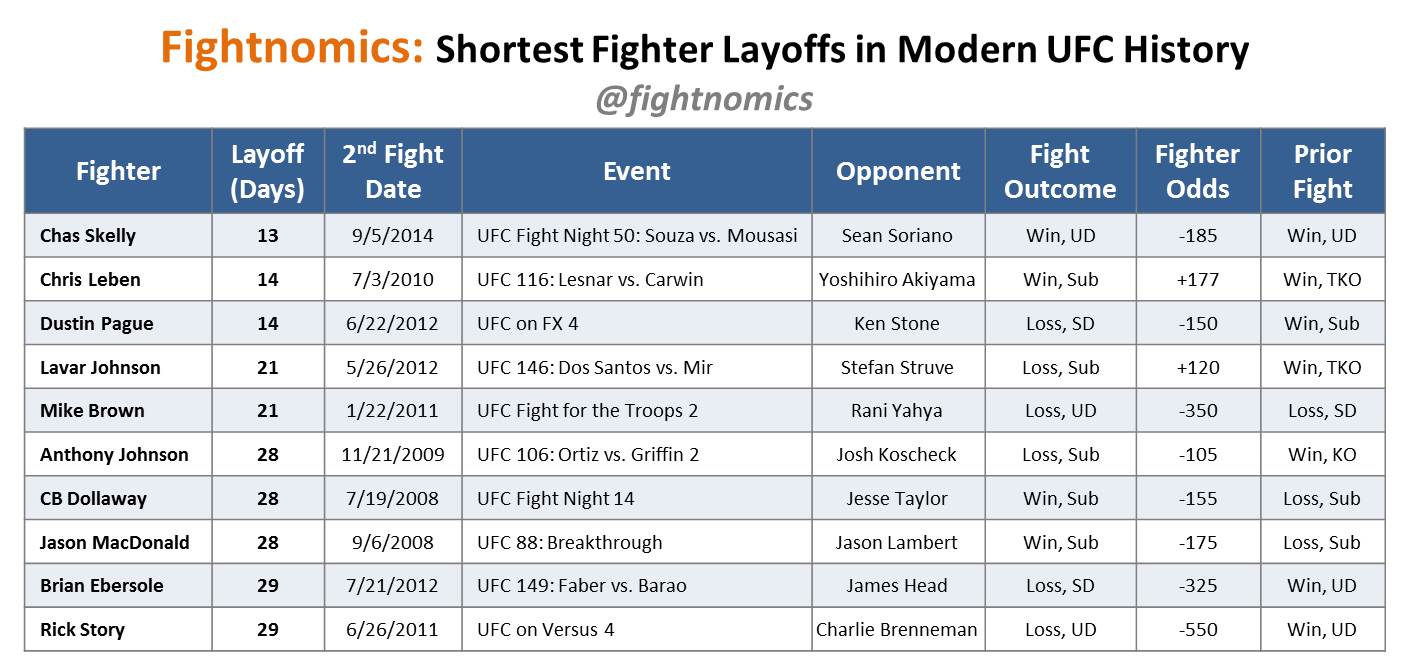By @fightnomics When Cowboy Cerrone soundly defeated Myles Jury at UFC 182, he extended his current win streak to six straight. More impressively, the win over Jury was the fifth win for Cerrone inside 12 months. But apparently the busy schedule isn’t busy enough for Cowboy, as he agreed to face Benson Henderson as a last-minute injury replacement for Eddie Alvarez. It will be just 15 days between fights for Cerrone, the fourth shortest turnaround in modern UFC history. Gone are the days of same night tournaments, replaced by highly regimented training camps, diets, and game plans. But Cowboy apparently has different priorities – fighting. He has always bucked trends, choosing to fight frequently and live a wild life of extreme sports outside the cage. At UFC 182 he looked blatantly casual between rounds, not even using the full allotted time to meet with coaches or even rest on a chair. So his decision to fight on short-notice should be no surprise, but the question remains: is it a good decision?
For more on layoff periods and other factors affecting MMA performance, get the book “Fightnomics” at Amazon.
The Big Picture First of all, short layoffs are rare. Really rare. Out of well over 4,000 fighters entering the Octagon since 2008, only 10 of them were returning on less than one-month’s rest. So 99.8% of the time, fighters have more time between fights. It’s important to note that we’re definitely working with a small sample size, so the conclusions we draw may not hold up in the future – but it’s still worth examining in more detail. The reasons for a short turnaround are varied. In most cases, an injury on an upcoming card opens a spot at a particular weight class, and a recent competitor fits the relative profile for the opponent and card position. Most of the time the substitution fighter is coming off a win (seven of ten), and of those that lost, two were caught in early submissions, and one lost a close split decision. In all cases, the fighters had to be cleared medically, and therefore the common trait for each fighter was that they were healthy. Presumably. A phone call coming so soon after a fight, or perhaps even a post-fight locker room visit from a matchmaker must certainly come as a surprise to a fighter who has just spent several months (on average) preparing for the opponent they just faced. And yet on these 10 occasions, fighters agreed to step into the Octagon for a second time in a month. The breed of individual who fights in cages for a living is not known for their risk aversion. But how did they do? Was it just another fight and a fair chance at success, or should they have passed on the opportunity for some quick show money? The numbers again are limited, but they reveal a 4-6 record for the 10 fighters fighting on short turnarounds. It’s not exactly a damning number, until we look a little deeper. The Fine Print Looking closer we can see a more sinister pattern. Again, the sample size is clearly tiny, but the Fighter Odds from these performances reveal a negative trend. In all but two cases the fighters stepping up on short notice were favorites, with one fighter a near pick ‘em according to the betting public, and only two slight underdogs. Adding up the expected wins based on their implied win probability comes out to 6.5. That means that out of these nine fighters, based on the market odds (which are generally accurate), they should have won six or seven fights. Instead, they only won four. Not a huge difference, but it doesn’t bode well. The imagination of these competitors probably showed most of them winning two paychecks and two win bonuses in one month equaling what they normally make in a year. However, the risk-seeking behavior of fighters may have led them astray. According to the market, this pool of fighters underperformed expectations by winning just four fights instead of six or seven. The intricacies of training, weight-cutting, and game-planning for specific opponents surely take time. It’s hard to know which part of the preparation process most suffers from a rapid turnaround, or if the lack of proper recovery from the prior fight was a greater detractor. For Cerrone, however, none of that matters. Cerrone’s aggressive lifestyle mirrors his aggressive fighting style, so we shouldn’t be surprised at all that he agreed to this fight on such short notice. The problem is that his opponent has already defeated him twice, making justifying a rematch in a 4th meeting more difficult should Cerrone lose. But we’re definitely going to watch, because not only was their first fight a barnburner, but what if he pulls off the upset? “Fightnomics” the book is now available on Amazon! Follow along on Twitter for the latest UFC stats and MMA analysis, or on Facebook if you prefer.
